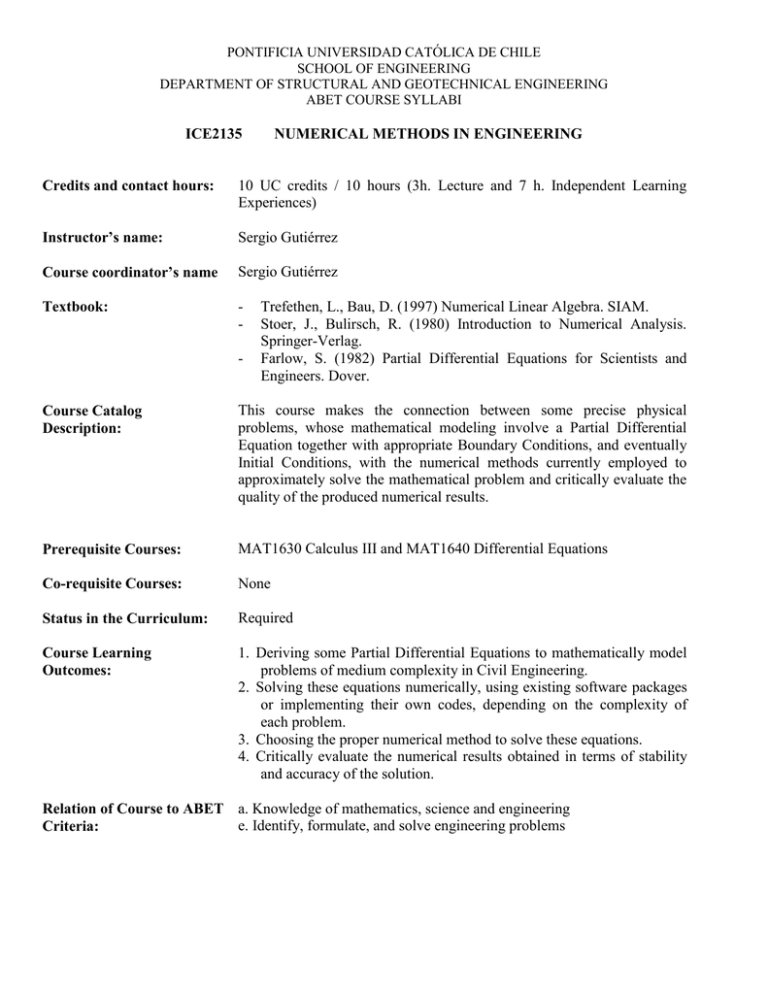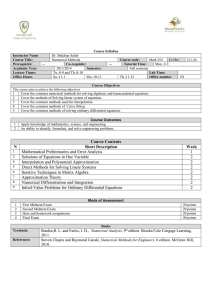ICE2135 NUMERICAL METHODS IN ENGINEERING Credits and
advertisement

PONTIFICIA UNIVERSIDAD CATÓLICA DE CHILE SCHOOL OF ENGINEERING DEPARTMENT OF STRUCTURAL AND GEOTECHNICAL ENGINEERING ABET COURSE SYLLABI ICE2135 NUMERICAL METHODS IN ENGINEERING Credits and contact hours: 10 UC credits / 10 hours (3h. Lecture and 7 h. Independent Learning Experiences) Instructor’s name: Sergio Gutiérrez Course coordinator’s name Sergio Gutiérrez Textbook: - Trefethen, L., Bau, D. (1997) Numerical Linear Algebra. SIAM. Stoer, J., Bulirsch, R. (1980) Introduction to Numerical Analysis. Springer-Verlag. Farlow, S. (1982) Partial Differential Equations for Scientists and Engineers. Dover. Course Catalog Description: This course makes the connection between some precise physical problems, whose mathematical modeling involve a Partial Differential Equation together with appropriate Boundary Conditions, and eventually Initial Conditions, with the numerical methods currently employed to approximately solve the mathematical problem and critically evaluate the quality of the produced numerical results. Prerequisite Courses: MAT1630 Calculus III and MAT1640 Differential Equations Co-requisite Courses: None Status in the Curriculum: Required Course Learning Outcomes: 1. Deriving some Partial Differential Equations to mathematically model problems of medium complexity in Civil Engineering. 2. Solving these equations numerically, using existing software packages or implementing their own codes, depending on the complexity of each problem. 3. Choosing the proper numerical method to solve these equations. 4. Critically evaluate the numerical results obtained in terms of stability and accuracy of the solution. Relation of Course to ABET a. Knowledge of mathematics, science and engineering e. Identify, formulate, and solve engineering problems Criteria: Topics covered: 1. The equilibrium heat equation is deduced for the isotropic homogeneus case and some difficulties inherent to the analytical and numerical solution are exposed. 2. Solving Algebraic Equations: direct and iterative methods to solve linear systems. Methods to solve non-linear equations: bipartition, régula falsi, Newton. Methods to solve non-linear systems: NewtonRaphson and variations. MATLAB. 3. Interpolation and function approximation: Lagrange Interpolation Polynomial, spline functions interpolation. Polynomial least squares approximation. Fourier approximation. MATLAB. 4. Numerical differentiation and integration: automatic differentiation methods, Richardson extrapolation, Newton-Cotes integration method and error bounds, Gaussian quadrature methods, Romberg method, adaptive methods. MATLAB. 5. Physical modeling and Finite Difference Method: meaning of the boundary conditions for the Laplace equation. Poisson equation. Problems with variable coefficients and their meaning. Flow in porous media. Elasticity system with displacement and tension boundary conditions. Numerical solution by finite differences: regular domains, irregular domains. Modeling of problems in transient regime: deduction of the heat equation, transport problems, and equations of sound waves. Numerical solution by finite differences: explicit methods and implicit methods, stability criteria. 6. The Finite Element Method: basics, Elements of Distribution Theory, formulation of variation problems, Solution of diffusion and elasticity problems on steady state. MATLAB and Free FEM++.

